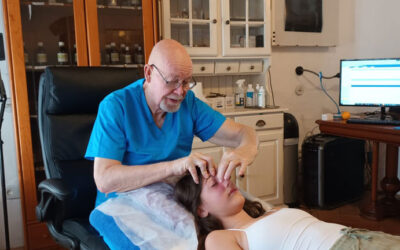Vivian, a female of 19 years of age, came to the clinic complaining of regular but painful periods that has gradually become worse over the last 10 years
She has visited her gynaecologist many occasions who prescribed anti-inflammatory drugs and the contraceptive pill. Within two periods she started to feel nauseous and suffered from migraines which, I feel, is a side effect of the drugs she was prescribed.
Approximately three months ago she was sent for an MRI of the pelvis to exclude pathology and to try and understand why she was having such painful periods.
Information clinical: Intense, disabling dysmenorrhea.
EXAMINATION REPORT
- Bladder is very full, thin-walled and regular
- Uterus in retroversion, anteflexion and slight right latero-shift, measuring approximately 8 x 4 x 3.5 cm in longitudinal, transverse and anteroposterior axes respectively.
- The myometrium is homogeneous. There is no anomalous thickening of the junctional zone and there are no nodular lesions attributable to leiomyomas. The endometrium is regular, with an estimated normal thickness of 4 mm.
- A small retention cyst measuring 5 mm was identified in the endocervical canal.
- Ovaries in their usual topography, with preserved morphostructure, with some infracentimeter follicular imageries visible bilaterally.
- No iliac or inguinal adenomegaly was identified.
- Free fluid in the fundus of the Douglas bag, considered physiological.
Please click on icon to show label
From the radiologist report there is an indication that the uterus is not in the correct position. We can see uterus is sidebent (latero-version) to the right producing congestion around the right ovary. The utero-sacral ligament is hyperintensive indicating tissue changes.

Utero-sacral Ligament
Sacrum
Bladder
Right latero-verted Uterus
Ovarian congestion
Rectum

Bladder
Uterus
Cyst
Vagina
Sacrum
Pubis
Please click on icon to show label
From the lateral view we can see a small cyst at the cervico-vagina junction along with anterio-flexion of the uterus and flexion of the coccyx.
The bladder is full and enlarged obstructing the uterus and surrounding structures.
Comments:
According to Dr Andrew Taylor Still, the founder of osteopathic medicine, structure (anatomy) affects function (physiology). The MRIs of Vivian’s pelvis shows structural anomalies which will interfere with the normal function of uterus and ovaries. The cyst may also prevent free flow of the menses. The utero-sacral ligament attaches to the sacro-spinous ligament which demonstrated a twitch response when palpated.
The treatment involved prolotherapy to the attachments of the sacro-spinous ligament followed a week later by osteopathic manipulation to the sacrum and coccyx.
It took a further two periods before Vivian felt pain relief during her periods. Osteopathic manipulation to the spine and pelvis continued during this period of time. Another MRI is recommended in six months time to check position and function of the uterus.
.


0 Comments